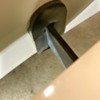.
There’s good news tonight. The clunk that launched a thousand wrenches has finally been dispatched. It has shuffled off this mortal torsion bar. It has been laid to rest. It is no more. It is an ex-clunk.
It sounded for all the world like it was coming from the suspension and setting up rattles in the steering column and up under the dash.
A pretty thorough check of the front end a few months back showed nothing obvious wrong with beam end bearings, trailing arms, ball joints, tie rod ends, steering box, steering column, Pitman arm, etc, etc. And this checking was by a competent mechanic with 30 years of AC VW experience.
The clunk had been bugging me for a long time, but started driving me nuts when I realized it was only getting worse over the past few months.
We did notice the front shocks were shot and riding on their bump stops, so those were replaced. That took some of the harshness out of the ride and reduced the clunking on rough surfaces, but only reduced it.
I realized the driver’s side hinge for the front deck lid is near the steering column up under the dash and so a possible source of the clunk. Both hinges were worn, so I replaced the bolts that serve as hinge pins and wrapped them in some strapping tape to isolate metal from metal and to take up any remaining play.
The clunk endured.
The next thing would be back to the mechanic to have the bumper brackets modified so they’ll no longer conflict with the front sway bar. This has been an issue since the car was new, but that means it existed even before the clunk. And before the clunk became The Clunk, and eventually THE CLUNK.
With a few days on my hands, I decided to clean up something else that had been bugging me for a while. On the driver’s side, where the front bumper bracket passes through a vertical slot in the fiberglass body, the bracket was resting on the bottom edge of the slot. Nothing serious, I thought, but a good thing to fix.
It turned out to be more complicated than it looked, as the bolts holding the front part of the bracket to the main part of the bracket (so you can adjust the vertical alignment of the bumper) were worn and gnarly. These were bolts that dream of someday growing up to be real bolts. They’re made from some sort of cardboard and applesauce amalgam. Bringing a wrench anywhere near them causes the heads to round off without any actual contact with the wrench. And, oh yeah, they were undersized for the job they were being asked to do.
Anyway, they were not fun getting out of there. The new ones popped right in and made the bumper height adjustment pretty easy. This was followed by the mandatory test drive to make sure that, like a conscientious physician, I had done no harm.
And, what the hey! The clunk, The Clunk, and THE CLUNK — all three— were completely and utterly gone. Like, totally!
That little bumper bracket had been the cause of all of my pain and suffering.
Some hindsight engineering analysis has led me to these conclusions.
The bumper bracket, which is bolted pretty solidly to the beam, was bouncing against the body shell whenever the front beam vibrated from road impact and the fiberglass (which is pretty hard stuff) was transmitting that vibration to anything that felt like resonating in time with the beat (remember those loose deck lid hinges).
Unknowingly, my Speedy and I (through negligent maintenance) had created the perfect rhythm section.
Anyway, the wicked clunk is dead.
Pay attention to the small stuff, kids.
And it’s all small stuff.
.






